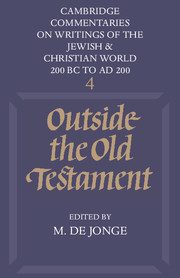Book contents
- Frontmatter
- Contents
- General Editors' Preface
- Editor's Foreword
- Acknowledgements
- Abbreviations
- General Introduction
- Pseudo-Philo, Liber Antiquitatum Biblicarum
- The Ethiopic Book of Enoch
- The Testament of Abraham
- The Testaments of the Twelve Patriarchs
- Joseph and Aseneth
- The Book of Jubilees
- The Testament (Assumption) of Moses
- The Psalms of Solomon
- The Martyrdom of Isaiah
- The Syriac Apocalypse of Baruch
- Paraleipomena Jeremiou
- The Testament of Job
- Index
The Testament (Assumption) of Moses
Published online by Cambridge University Press: 05 June 2012
- Frontmatter
- Contents
- General Editors' Preface
- Editor's Foreword
- Acknowledgements
- Abbreviations
- General Introduction
- Pseudo-Philo, Liber Antiquitatum Biblicarum
- The Ethiopic Book of Enoch
- The Testament of Abraham
- The Testaments of the Twelve Patriarchs
- Joseph and Aseneth
- The Book of Jubilees
- The Testament (Assumption) of Moses
- The Psalms of Solomon
- The Martyrdom of Isaiah
- The Syriac Apocalypse of Baruch
- Paraleipomena Jeremiou
- The Testament of Job
- Index
Summary
In 1861 Antonio Ceriani published a fragmentary Latin manuscript which he had found in the Ambrosian Library in Milan and which he identified as the Assumption of Moses. The identification was based on chapter 1 verse 14, which corresponds to a quotation from the Assumption of Moses by Gelasius (Ecclesiastical Historyii.17.17). Gelasius elsewhere (ii.21.7) refers to the dispute between Michael and the Devil in the Assumption of Moses. This episode is not found in the manuscript published by Ceriani, but is often referred to in patristic sources and even already in the New Testament in Jude, verse 9. (The allusion is not identified in Jude but is specified in Clement, Origen and other patristic sources.) The Latin manuscript does not refer to the death of Moses or his subsequent assumption at all and, since it is primarily a prophecy delivered before death, it is more properly described as a testament. In fact the Stichometry of Nicephorus and other lists mention a Testament (Diathēkē) of Moses immediately before the Assumption, and the dominant opinion of scholars is that Ceriani's text corresponds to the Testament rather than the Assumption. In view of the citations in Gelasius, some have suggested that the Testament and the Assumption were combined in a single book. The surviving Latin text is incomplete, and may have concluded with an account of the assumption of Moses.
- Type
- Chapter
- Information
- Outside the Old Testament , pp. 145 - 158Publisher: Cambridge University PressPrint publication year: 1986



